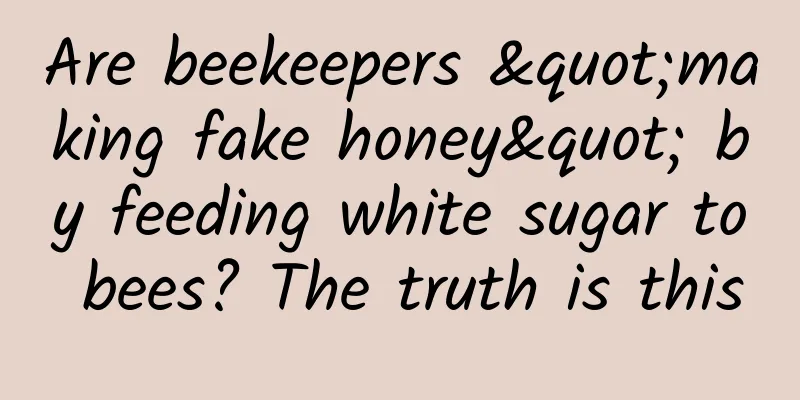Are beekeepers "making fake honey" by feeding white sugar to bees? The truth is this

|
Not long ago, a video about bees became a hot topic. Many little bees gathered on the candied haws, so densely packed that they looked like a swarm of flies . Image source: Weibo screenshot Why are these bees attracted to the candied haws? What do they do on the candied haws? Can they still be eaten? There is a rumor that beekeepers feed the bees with sugar. Is this true? Don’t be in a hurry, we first need to understand the relationship between bees, nectar and honey . Nectar and Honey Bees collect flowers to make honey, which is a knowledge point that kindergarten children all know. However, not many people really know what the specific operation steps are. Some people say that honey is nectar, some people say that honey is bee excrement, and some people say that honey is nectar mixed with pollen. In fact, these statements are not correct. The relationship between honey and nectar is that, to be precise, nectar is the raw material . Nectar comes from plants, and although the size, shape, color and fragrance of different flowers are different, as long as it is nectar , the main ingredient is sucrose . Copyright image, no permission to reprint Bees carry nectar back to the hive. Then, does the nectar become honey? It's not that simple. Nectar is just the raw material. Then the bees have to process it . The worker bees are responsible for collecting nectar. They store the nectar in their honey sacs and secrete special enzymes to break down the sucrose in the nectar . After returning to the hive, the worker bees will spit out the nectar and give it to the housekeeper bees. The house bees start to make honey. The specific steps are to suck and spit, suck and spit continuously, so that the sucrose in the nectar is continuously decomposed and further converted into fructose and glucose . At the same time, the house bees will also use the principle of fanning evaporation to reduce some of the water in the semi-finished honey. At the same time, the bees will also absorb some of the water in the semi-finished honey during the process of sucking and spitting. The moisture content of the honey finally formed is generally less than about 20% . Once the quality of the honey meets the standards, the bees will seal the finished honey in small compartments made of beeswax, which will serve as the reserve food for the entire bee colony. To sum up, honey is the product of the nectar collected by bees being swallowed and spit out. Imagine the picture, isn’t it shocking? In the process of making honey, most of the sucrose in nectar is broken down into fructose and glucose . Among them, the sweetness of fructose is 1.8 times that of sucrose, which should be sweeter than sucrose. However, the glucose in honey lags behind, and their sweetness is only 0.6 times that of sucrose. Therefore, the sweetness of honey as a mixture of the two is basically equivalent to that of sucrose. Copyright image, no permission to reprint By the way, our perception of the sweetness of honey is directly related to temperature. This is because the sweetness of fructose, the main source of honey 's sweetness, is closely related to temperature . I don't know if you have noticed that colder honey is sweeter. Under low temperature conditions, the configuration of fructose will change, making our tongue feel sweeter, so there is a scientific basis for the fact that honey is sweeter when eaten cold. Why do bees eat sugar? In the news mentioned at the beginning, bees sucked desperately on the candied haws. Why is that? Shouldn't they prefer flowers? In fact, knowing that the raw material of honey is nectar, and the main component of nectar is sucrose, this news is not difficult to understand. Bees collect nectar very hard . To make 1 tablespoon of honey, bees need to visit 2,000-3,000 flowers. If there is a ready-made large amount of "convenient nectar source" in front of you, why bother to collect nectar? After all, there is sucrose on the candied haws, which is easier to collect, so bees will naturally like it. Artificial feeding of sugar is also a common practice in the beekeeping industry . In autumn and winter, when flowers are scarce, beekeepers will feed the bee colonies with sugar to ensure the vitality of the bee colonies. Copyright image, no permission to reprint Generally speaking, bees will store up food for the winter . However, since human beekeepers take away a lot of their honey, bee colonies that fail to store enough honey will face the risk of starvation, and may even starve to death. Therefore, in the autumn and winter seasons, beekeepers must supplement the food for the bees, and white sugar is obviously the best choice. Bees will also carry white sugar back to the hive to brew and store it , but the honey "produced" with white sugar lacks the unique flavor substances of nectar, such as the jujube fragrance of jujube honey and the locust flower fragrance of locust flower honey. In addition, honey made with white sugar as raw material will have a higher sucrose content. However, there is no need to worry too much that beekeepers will use white sugar to make honey for adulteration, because it costs money to feed bees with white sugar, and nectar is obtained by bees for free from plants, so it is not cost-effective to use white sugar to adulterate it. Nectar is sweet and bitter It was mentioned above that the main component of nectar is sucrose, and then there are some flavor substances. In fact, in addition to sweetness and fragrance, some nectar may also contain bitter substances ! For example, the nectar of citrus flowers contains a small amount of caffeine , and it is this little bitter substance that makes bees prefer to collect citrus nectar. This is because caffeine can also stimulate the bee's brain, especially a brain area called mushroom body, which is related to the learning and memory of smells. The intake of caffeine makes bees deeply remember the skills of collecting nectar on citrus flowers. Yes, you read that right, bees also like caffeine . Copyright image, no permission to reprint Of course, bitter nectar has some special effects, which is to force bees to leave after collecting a certain amount . After all, bitter substances are unbearable for bees, and bees cannot collect too much at a time . The bees that leave in a hurry will carry pollen to farther places. For plants, this can increase the distance of pollination. Secondly, the "reward" (nectar) paid at a time is relatively small, which is obviously more cost-effective. After all, it takes a lot of energy for plants to secrete a large amount of nectar. But it's a pity for the bees, the "workers". Moreover, the "wisdom" of plants continues to our dining table, and our tongues have to suffer a little bit. Author: Shi Jun Review | Yao Jun Associate Researcher, Bee Research Institute, Chinese Academy of Agricultural Sciences The cover image and the images in this article are from the copyright library Reproduction of image content is not authorized |
<<: Who would dare to eat the black widow that can poison 10 mice to death at once? !
>>: Nature News: What makes paralyzed people walk again? Scientists have made a new discovery
Recommend
Refuse routines! Ministry of Industry and Information Technology: Advertising plug-ins are strictly prohibited in the elderly version of App
[[411852]] With the rapid development of Internet...
iOS 14.5 no longer defaults to female voice, English Siri adds two new voices
Apple released the iOS 14.5 beta 6 beta system. F...
Follow the satellite to travel Ningbo丨See the sea along the canal
The Grand Canal of China (including the Grand Can...
What are the functions of the community property management mini program? How much does it cost to develop a property management app?
In order to improve the management efficiency of p...
Google's quantum computer runs 100 million times faster than traditional computers
What? Google's own quantum computer is 100 mi...
SMMT: UK new car registrations fell 34.9% in June 2020
According to data released by the SMMT, new car r...
Are these “mysterious circles” in the desert really the work of aliens?
In the desert grasslands of Namibia in southern A...
MG India focuses on sustainable development to build a green travel ecosystem SAIC Motor and India's JSW Group sign a strategic cooperation agreement
(Shanghai, November 30, 2023) Recently, SAIC Moto...
AppBase new applications (April 8) | "iTel Money Maker" takes the lead
All new apps on AppBase are in the entrants quadr...
Solar flares: Will the sun's sneeze eat up radio signals?
Solar flares are sudden and bright phenomena on t...
Why do you feel sore all over when you have a fever? It's actually a sign that your protection is about to be upgraded
Produced by: Science Popularization China Author:...
Activity operation review data indicators!
After each activity, it is necessary to review th...
SEO order-taking platform, what is the order-taking process for SEO outsourcing services?
Many people who are good at SEO like to provide S...
Where exactly will the national unified market be built? What are the impacts on ordinary people?
Recently, news about my country's plan to esta...
Did Andy Lau come? Let's discuss the "cool" technology of the Spring Festival Gala in the Year of the Ox
The annual Spring Festival Gala has come to an en...









